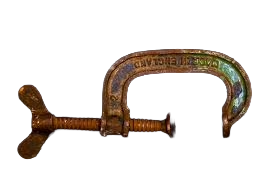Why You Should NEVER Use Off-the-Shelf C-Clamps for as Strongbacks
In industrial environments, leak repair is one of the most sensitive maintenance activities. The systems we’re dealing with often operate under high pressures, elevated or cryogenic temperatures, and strict compliance requirements. Because of this, every tool and component used in a repair must meet defined engineering standards.
Every so often, the question arises: “Can I use an off-the-shelf C-clamp as a strongback on a flange?” The short answer is no — and in this article, we’ll explore four key reasons why C-clamps are not suitable for leak repair applications. We’ll also connect these risks to relevant ASME codes that govern pressure-containing equipment.
1. Material and Quality Control
C-clamps from hardware stores are not manufactured with Material Test Reports (MTRs) available to consumers. Without MTRs, there is no verified record of:
Chemical composition of the alloy.
Mechanical properties such as tensile strength and yield strength.
Traceability to heat treatment or batch production.
In ASME-regulated systems (such as those covered under ASME B31.1, B31.3, or Section VIII, Division 1), material traceability is mandatory. Using an uncertified clamp introduces unknowns that may compromise compatibility with the process fluid, temperature range, or pressure conditions.
Implication: A clamp that looks solid may corrode prematurely, fail under thermal cycling, or react chemically with the service medium — leading to sudden loss of containment.
2. Safety Factors
C-clamps are designed for woodworking or light mechanical duty, where failure has minimal consequence. In contrast, pressure systems store energy in the form of pressure, and any failure can release that energy violently.
ASME codes dictate specific design factors of safety when containing pressure.
For example:
ASME B31.3 requires stress limits based on allowable stress design.
ASME Section VIII provides rules for pressure vessel components with minimum safety margins.
An uncertified clamp does not account for these factors. A failure doesn’t just mean a minor leak — it could result in a sudden rupture or even an explosion, putting personnel and equipment at severe risk.
Implication: Treating pressure clamps like woodworking tools underestimates the stored energy of pressurized systems. A single failure could escalate into a catastrophic incident.
3. Casting Defects and Brittleness
Most off-the-shelf C-clamps are made from cast iron or similar alloys. While these materials are inexpensive, they are prone to:
Voids and inclusions that weaken the structure.
Brittle fracture under impact or stress.
Poor toughness at low temperatures.
Industrial strongback clamps are instead fabricated from forged or machined materials with documented inspection and nondestructive testing (NDT). Without inspection records, there’s no way to ensure that a cast clamp won’t snap unexpectedly under load. In a pressure-retaining application, brittle failure is unacceptable.
Implication: A cracked clamp on a flange could turn a controlled leak into a high-velocity jet release, exposing workers to burns, chemical exposure, or mechanical trauma.
4. Temperature Limitations
Some consumer-grade clamps are marketed with load ratings (e.g., “Rated for 1000 lbs”). However, these ratings apply only at ambient conditions (20–25 °C / ~70 °F). In industrial service, piping and vessels often range from -55 °F to over 1000 °F (-48 °C to 538 °C), or sometimes even more extreme temperatures.
At elevated or cryogenic temperatures, material properties change significantly:
Loss of strength at high temperatures.
Brittleness and ductile-to-brittle transition at low temperatures.
Accelerated creep or fatigue under cyclic loads.
ASME standards require materials to be derated according to temperature. Since the properties of a C-clamp are unknown, its load rating is meaningless in these conditions.
Implication: A clamp rated for 1000 lbs in a catalog may only support a fraction of that load at 500 °F, making it dangerously unreliable.
The ASME-Compliant Alternative
Instead of improvising with uncertified clamps, leak repair should employ:
Engineered clamp systems designed in accordance with the appropriate ASME code.
Materials with MTR traceability, ensuring compatibility with process conditions.
The appropriate Safety factors built into design for the specific application.
These engineered solutions provide the assurance that repairs will be safe, effective, and compliant with regulatory requirements.
Final Thoughts
Off the shelf C-clamps have their place in the shop, but not in the field for industrial leak repair. Using them compromises safety, regulatory compliance, and equipment integrity. By following ASME standards and relying on engineered solutions, we not only protect our systems but also safeguard the people who operate them.
When it comes to pressure containment, there is no room for shortcuts.
If you found this information useful and want to learn more about advanced leak repair methods, don’t forget to subscribe to our channel or join our mailing list. We share new insights and tutorials regularly—stay ahead of your maintenance challenges by staying informed.



